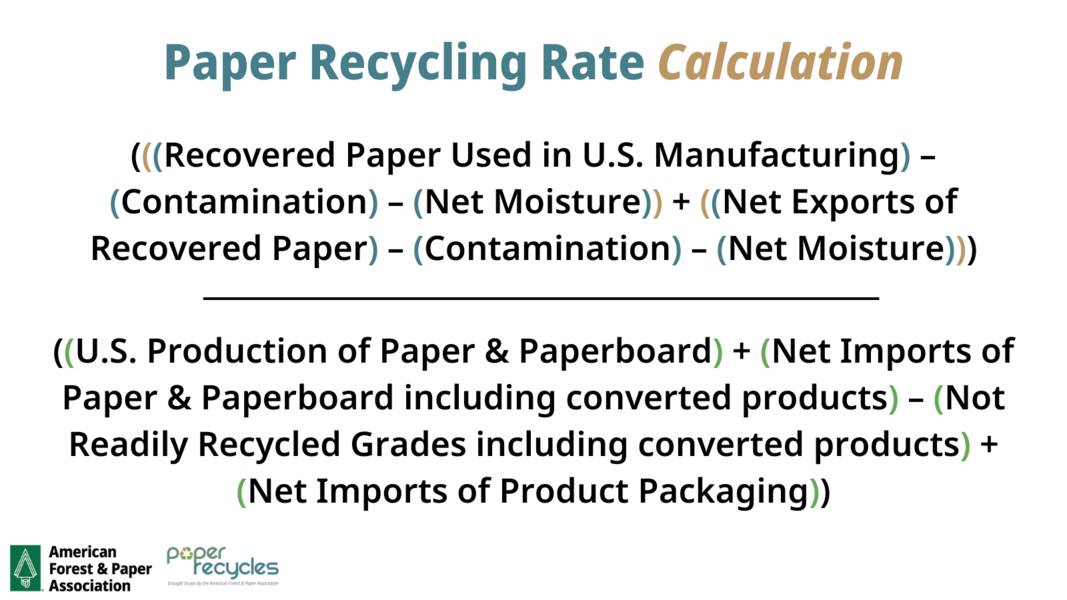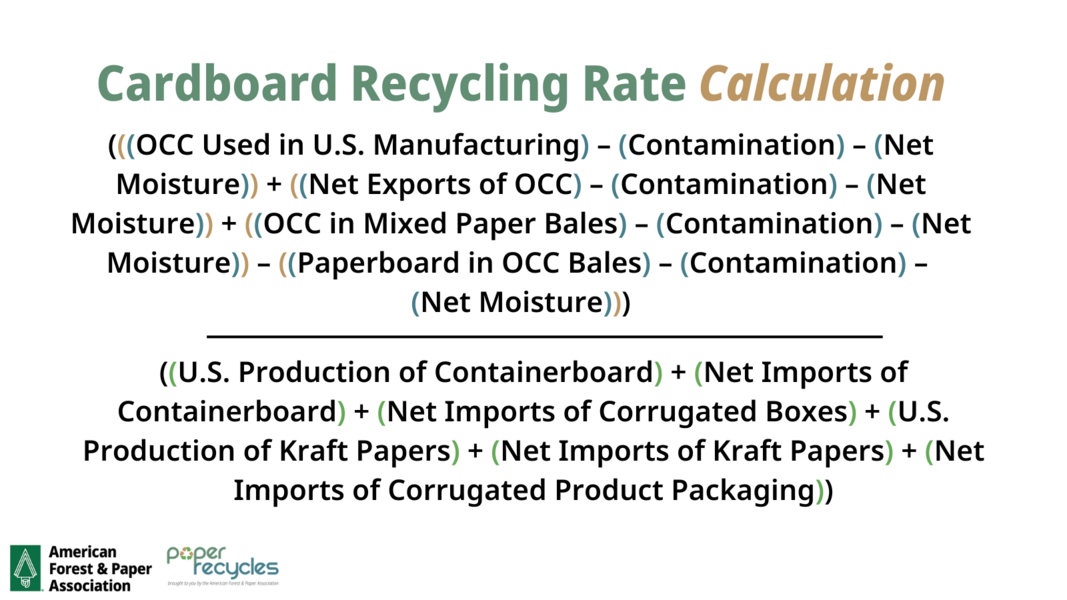AF&PA Recycling Rate Methodology
AF&PA’s recycling rate statistics incorporate all primary collection channels, including industrial, commercial, institutional and residential.
Our updated methodology utilizes extensive industry data, subject matter expertise and detailed U.S. trade data.
What are the Paper and Cardboard Rate Calculations?


AF&PA made 4 key updates to our recycling rate methodology:
- We improved our estimate of net imported product packaging using more detailed trade data and better estimates for packaging dimensions.
- We deducted an estimate of materials in recovered paper bales that are not used in manufacturing (e.g., paper not suitable for use in the specific grade; non-paper materials; net moisture).
- In the cardboard recycling rate calculation, we made adjustments for cardboard and other paper-based consumer packaging in different grades of commodity bales.
- Provided our rates as a range to acknowledge aspects of the calculations are based on estimates.
Further, we engaged an independent, highly-credentialed third-party reviewer to examine our methodology and findings to ensure their rigor and validity. This external review process found that AF&PA’s recycling rate is in strong alignment with other trusted industry experts.
How Does the New Rate Calculation Compare to the Previous Rate?
The Previous Rate
Previously, the AF&PA paper recycling rate measured the amount of paper recycled as a share of the amount of paper used.
For our purposes, this means the amount of paper and paper-based packaging (i.e. paperboard) recovered for recycling compared to how much new paper was produced in the U.S. plus net imports of new paper and paperboard.
To get the amount of paper used, we included:
- U.S. production of paper and paperboard.
- Imports and exports of finished paper and paperboard. That means things such as large parent rolls and converted products like flat boxes or office paper.
The New Rate
The new paper recycling rate is calculated as the amount of paper recycled as a share of the amount of paper available for recovery.
For our purposes, the calculation for paper available for recovery means how much readily recyclable paper and paperboard the industry recycled.
To get how much paper is available to be recycled, we made updates to include:
- Net imports of product packaging, which are boxes used to ship things like produce, clothing and electronics.
- Adjustments for contamination and moisture. For our purposes, contamination means unusable material.
- An adjustment for not readily recycled grades.
Similar to the previous rate, the calculation still includes:
- U.S. production of paper and paperboard.
- Imports and exports of finished paper and paperboard.
What are the Updates to the Net Imported Product Packaging Estimate?
The updated methodology involves a more extensive analysis of U.S. trade data using more granular commodity data at the HTS 4-digit code level.
The calculations include estimating packaging content for:
- Ocean container trade calculated on a per container basis
- Canada & Mexico trade calculated on a dollar value basis
- International Air Freight trade calculated on a dollar value basis
What is Included in the Packaging Dimensions Estimate?
For those instances where we do not have specific packaging data from commodities, the calculation of the amount (tons) of packaging involves a series of estimates on:
- The average volume of packages in a container
- The translation of the volume to surface area
- The translation of surface area to weight
- The determination on the type of paper-based packaging
Why are the Rates Expressed in a Range?
Aspects of the calculations are based on estimates, which makes the rates best expressed as a range.
For example, exports and imports of boxes used as product packaging are not directly measured and are difficult to estimate.
We believe our methodology, especially for estimating product packaging imports/exports, is the most thorough and fact-based possible with currently available data. No matter how you measure it, paper recycling is an environmental success story.
Have additional questions? Contact us at comm@afandpa.org.
